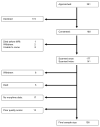Smaller Cerebellar Growth and Poorer Neurodevelopmental Outcomes in Very Preterm Infants Exposed to Neonatal Morphine
- PMID: 26763312
- PMCID: PMC5462546
- DOI: 10.1016/j.jpeds.2015.12.024
Smaller Cerebellar Growth and Poorer Neurodevelopmental Outcomes in Very Preterm Infants Exposed to Neonatal Morphine
Abstract
Objective: To examine the relationship between morphine exposure and growth of the cerebellum and cerebrum in very preterm neonates from early in life to term-equivalent age, as well as to examine morphine exposure and brain volumes in relation to neurodevelopmental outcomes at 18 months corrected age (CA).
Study design: A prospective cohort of 136 very preterm neonates (24-32 weeks gestational age) was serially scanned with magnetic resonance imaging near birth and at term-equivalent age for volumetric measurements of the cerebellum and cerebrum. Motor outcomes were assessed with the Peabody Developmental Motor Scales, Second Edition and cognitive outcomes with the Bayley Scales of Infant and Toddler Development, Third Edition at 18 months CA. Generalized least squares models and linear regression models were used to assess relationships between morphine exposure, brain volumes, and neurodevelopmental outcomes.
Results: A 10-fold increase in morphine exposure was associated with a 5.5% decrease in cerebellar volume, after adjustment for multiple clinical confounders and total brain volume (P = .04). When infants exposed to glucocorticoids were excluded, the association of morphine was more pronounced, with an 8.1% decrease in cerebellar volume. Morphine exposure was not associated with cerebral volume (P = .30). Greater morphine exposure also predicted poorer motor (P < .001) and cognitive outcomes (P = .006) at 18 months CA, an association mediated, in part, by slower brain growth.
Conclusions: Morphine exposure in very preterm neonates is independently associated with impaired cerebellar growth in the neonatal period and poorer neurodevelopmental outcomes in early childhood. Alternatives to better manage pain in preterm neonates that optimize brain development and functional outcomes are urgently needed.
Copyright © 2016 Elsevier Inc. All rights reserved.
Conflict of interest statement
The authors declare no conflicts of interest.
Figures
Comment in
-
Impaired Neurodevelopmental Outcomes in Very Preterm Infants: Much Too Easy to Blame It Just on Morphine!J Pediatr. 2016 May;172:7-8. doi: 10.1016/j.jpeds.2016.01.071. Epub 2016 Feb 16. J Pediatr. 2016. PMID: 26896158 No abstract available.
-
Morphine exposure in preterm infants correlates with impaired cerebellar growth and poorer neurodevelopmental outcome.Evid Based Med. 2016 Dec;21(6):234. doi: 10.1136/ebmed-2016-110511. Epub 2016 Oct 19. Evid Based Med. 2016. PMID: 27760778 No abstract available.
Similar articles
-
Multiple Postnatal Infections in Newborns Born Preterm Predict Delayed Maturation of Motor Pathways at Term-Equivalent Age with Poorer Motor Outcomes at 3 Years.J Pediatr. 2018 May;196:91-97.e1. doi: 10.1016/j.jpeds.2017.12.041. Epub 2018 Feb 2. J Pediatr. 2018. PMID: 29398063
-
Brain Volumes at Term-Equivalent Age in Preterm Infants: Imaging Biomarkers for Neurodevelopmental Outcome through Early School Age.J Pediatr. 2016 May;172:88-95. doi: 10.1016/j.jpeds.2015.12.023. Epub 2016 Jan 7. J Pediatr. 2016. PMID: 26774198
-
Midazolam dose correlates with abnormal hippocampal growth and neurodevelopmental outcome in preterm infants.Ann Neurol. 2016 Apr;79(4):548-59. doi: 10.1002/ana.24601. Epub 2016 Feb 15. Ann Neurol. 2016. PMID: 26754148
-
Cerebellar injury in preterm infants.Handb Clin Neurol. 2018;155:49-59. doi: 10.1016/B978-0-444-64189-2.00003-2. Handb Clin Neurol. 2018. PMID: 29891076 Review.
-
Cerebellar hypoplasia of prematurity: Causes and consequences.Handb Clin Neurol. 2019;162:201-216. doi: 10.1016/B978-0-444-64029-1.00009-6. Handb Clin Neurol. 2019. PMID: 31324311 Review.
Cited by
-
Personal perspectives: Infant pain-A multidisciplinary journey.Paediatr Neonatal Pain. 2020 Apr 28;2(2):50-57. doi: 10.1002/pne2.12017. eCollection 2020 Jun. Paediatr Neonatal Pain. 2020. PMID: 35548594 Free PMC article. Review.
-
Development and Usability Evaluation of a Desktop Software Application for Pain Assessment in Infants.Can J Pain. 2018 Nov 14;2(1):302-314. doi: 10.1080/24740527.2018.1540261. eCollection 2018. Can J Pain. 2018. PMID: 35005387 Free PMC article.
-
Effects of less invasive surfactant administration (LISA) via a gastric tube on the treatment of respiratory distress syndrome in premature infants aged 32 to 36 weeks.Medicine (Baltimore). 2020 Feb;99(9):e19216. doi: 10.1097/MD.0000000000019216. Medicine (Baltimore). 2020. PMID: 32118723 Free PMC article. Clinical Trial.
-
Validation of a Paralimbic-Related Subcortical Brain Dysmaturation MRI Score in Infants with Congenital Heart Disease.J Clin Med. 2024 Sep 27;13(19):5772. doi: 10.3390/jcm13195772. J Clin Med. 2024. PMID: 39407833 Free PMC article.
-
Fentanyl Exposure in Preterm Infants: Five-Year Neurodevelopmental and Socioemotional Assessment.Front Pain Res (Lausanne). 2022 Mar 1;3:836705. doi: 10.3389/fpain.2022.836705. eCollection 2022. Front Pain Res (Lausanne). 2022. PMID: 36061415 Free PMC article.
References
-
- Kaneyasu M. Pain management, morphine administration, and outcomes in preterm infants: a review of the literature. Neonatal Network. 2012;31:21–30. - PubMed
-
- Bellu R, de Waal K, Zanini R. Opioids for neonates receiving mechanical ventilation: a systematic review and meta-analysis. Arch Dis Child Fetal Neonatal Ed. 2010;95:F241–251. - PubMed
-
- Massa H, Lacoh CM, Vutskits L. Effects of morphine on the differentiation and survival of developing pyramidal neurons during the brain growth spurt. Toxicol Sci. 2012;130:168–179. - PubMed
-
- Bekheet SH, Saker SA, Abdel-Kader AM, Younis AE. Histopathological and biochemical changes of morphine sulphate administration on the cerebellum of albino rats. Tissue Cell. 2010;42:165–175. - PubMed
Publication types
MeSH terms
Substances
Supplementary concepts
Grants and funding
LinkOut - more resources
Full Text Sources
Other Literature Sources
Medical



